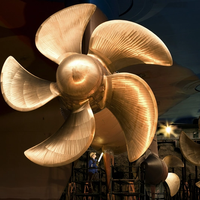ABB Propulsion for China-Built Cruise Ship

China’s first domestically built cruise ship, to be built at Shanghai Waigaoqiao Shipbuilding Co., Ltd. (SWS), will feature a power and propulsion package from ABB.From ABB's perspective the deal includes two Azipod steerable propulsion systems for the 323m vessel, due for delivery in 2023. The ship will be built to accommodate 5,000 passengers and is designed to suit the tastes of Chinese cruise travelers whose numbers are expected to rise to 8-10 million annually by 2025, according to industry body Cruise Lines International Association (CLIA).In addition to the Azipods…
STX, Schottel to Produce Propulsion Systems

The South Korean company STX Heavy Industries Co., Ltd. and Schottel will be cooperating in the area of large rudder propeller systems for underwater installation, as used on drilling rigs, for example. Within the framework of a corresponding licence agreement, STX will manufacture rudder propellers covering a power range from 2000 to 5800 kW, while Schottel will supply the core components for these systems in the form of the L gearbox. The first STX-Schottel Rudder propellers are due for delivery in the second half of 2010.
Design Analysis of Shirley Irene
The 140 x 46 ft. ferry vessel, Shirley Irene, was constructed in 1991 on the Gulf Coast, for operation in Lake Erie, out of Marblehead, Ohio. The original design concept was conceived by DeJong & Lebet, Inc., Jacksonville, Fla., and Ed von Bergen. The owner's requirements were for an inexpensive, open-deck vehicle ferry, with a high degree of maneuverability, for local wind and other weather conditions, along with double-ended capability. Simplicity of operation was also important. The owner also required some increased protection for the exposed vehicles on the open deck. There were several design considerations, which ultimately determined the final vessel configuration. Most of these related to the maneuverability and thus, the propulsion system of the vessel.







